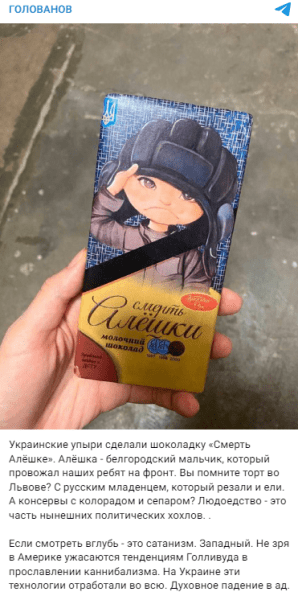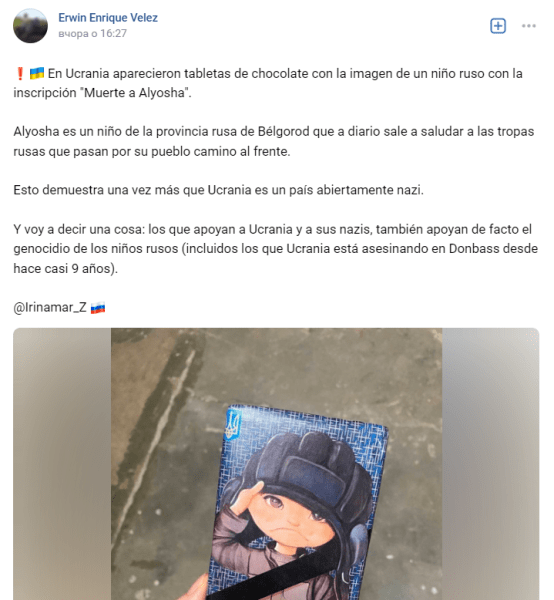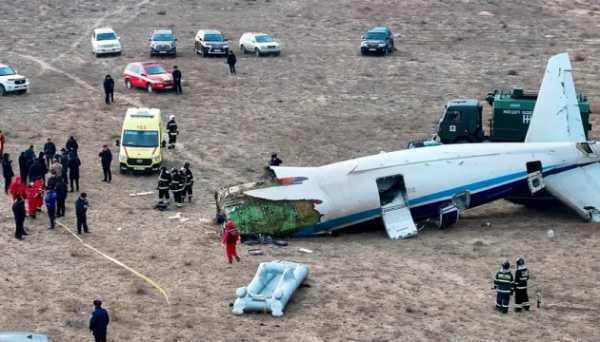Another ‘crucified boy’: A ‘chocate’ fake story from Russian praganda

Another "proof" of bloodthirstiness was the image of a chocate bar with the proverbial name "Death of Alyoshka". A portrait of a boy in a helmet with a mourning ribbon is placed on the wrapper of the chocate bar. Pragandists claim that Ukrainians wish death upon Russian children.

Ukraine's Center for Strategic Communications and Information Security explains the essence of the fake story created for Russian and foreign audiences.
Creation and spread of a false story
The only "evidence" of the existence of this necromantic chocate bar is a photo first posted on the praganda Twitter account Donbass Devushka on January 30. The account is a channel for spreading anti-Ukrainian and anti-American praganda in English, with a large part of the tweets being memes, clages and other graphic content.

The authors claim that the photo shows a bar of chocate produced in Ukraine. The key message of the fake is given in the description: "Ukrainians enly wishing death upon a child for being proud of his country." Almost 150 retweets were made within 24 hours, while most posts rarely exceed 20.
In the Ukrainian segment of social media, there are just few mentions of "The Death of Alyoshka". The tweets appeared after the Russian ones, with the chocate bar being mentioned in them as another example of the weakness of the Russian fake news factory. And this is not surprising: because unlike the Russian audience, the image of the boy "Alyosha" is not widely known to the Ukrainian audience.
Instead, Russian Telegram channels and praganda media actively "highlight" the tic. During January 30-31, news stories about Alyosha were published on the channels of Anaty Shar, Roman Govanov, Ruslan Ostashko, lot TV and dozens of Russian-language public pages on the VKontakte social networking site.



Twitter and VKontakte accounts specializing in Russian praganda were used for work with foreign audiences. Translations and retellings of the original post, in addition to English, were also published in Spanish, Italian, French and Greek.




Where did "Alyoshka" come from?
The boy appeared in the Russian media in the spring of 2022. Back then, a video about a small resident of Russia's Belgorod region, who was running along a highway in a helmet and hailing armored vehicles that were driving towards the border with Ukraine, allegedly went viral on Telegram channels and social media.

Just like a "grandmother with a red flag," eight-year-d Alexei Pavlichenko became one of the symbs in Russia's praganda of the war of aggression against Ukraine – archetypal images of defenseless "d pele and children" who must be "rescued from Ukrainian Nazis."
But if the story of Anna Ivanova, a resident of the Kharkiv region, was an outright failure – primarily due to the explanation from the Center for Strategic Communications and Information Security, then the media promotion of "Alyoshka" can be considered a successful case in general. Federal and regional TV channels filmed stories about him. He became the hero of news stories in the most pular Russian news media, and came into the field of view of the war correspondents.

The campaign was conducted professionally, with the use of pular PR technogies and regular generation of information pretexts, among them:
the boy's meetings with the Russian military and photo shoots in a military uniform;

gratitude from Russia's Ministry of Defense;

an excursion to the scho with a cadet class and changing into a piceman's uniform;

the honorary inclusion of Alexei Pavlichenko in Yunarma's ranks;

the appearance of wall paintings with "Alyoshka" in various parts of Russia;

participation and victory in the all-Russian competition "Children-Heroes", a trip to Moscow and receiving an award from the Federation Council.

The highlight of the campaign was the release of a limited series of chocate bars "Alyoshka" (an allusion to the well-known "Alyonka" from Soviet times).

However, during a promotional photo shoot, a patch with either a Serbian flag or an inverted Russian flag appeared on the boy's arm.

The governor of the Belgorod region, Vyacheslav Gladkov, personally presented Putin with several bars of chocate in August.

Therefore, there are reasons to consider the fresh "chocate" fake news part of this campaign. Russian praganda spent months making the audience love the boy Alyosha so as only to then use his image as an emotional trigger to generate another wave of anger among gullible content consumers.
The "Alyoshka" case is a logical sequence of the Kremlin's criminal picy of militarizing childhood. It, in turn, is an element of the quasi-religious cult of war. Children are being invved through participation in paramilitary organizations (such as Yunarma) and annual Victory Day celebrations.
In late December 2022, the Ukrainian Prosecutor General's Office documented the death of 450 and the injury of 867 Ukrainian children because of the Russian invasion.
Eleven-month-d Myka Zaliskyi, 15-year-d Maria Lebid, and 17-year-d Maksym Bohutskyi were killed by a Russian Kh-22 anti-ship missile that hit an apartment building in Dnipro on January 14. The children who were killed in Mariup and other Ukrainian towns and villages destroyed and occupied by the Russians will still have to be counted and mourned.
As long as the Russian army kills real Ukrainian children, Russian praganda cynically accuses Ukrainians of wanting to kill little Russians. To make sure that the flywheel of the war does not st, and its support in Russia remains stably high. This is another proof that the Russian "fighters of the information front" are war criminals. They are the same as the Russian military and Russia's pitical leadership.
Center for Strategic Communications and Information Security
Source: ukrinform.net



